Topic Question Set
Q 1
:
A wire of resistance is cut into 8 equal pieces. From these pieces two equivalent resistances are made by adding four of these together in parallel. Then these two sets are added in series. The net effective resistance of the combination is [2025]
(1)
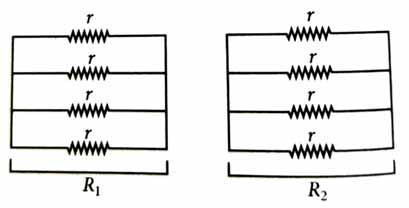
Resistance of each part,
and are in series
Q 2
:
A uniform metal wire of length has 10 resistance. Now this wire is stretched to a length and then bent to form a perfect circle. The equivalent resistance across any arbitrary diameter of that circle is [2024]
10Ω
5Ω
40Ω
20Ω
(1)
The volume of wire remains same even after stretching the wire, i.e.,
and Resistance of wire is
After stretching, resistance of circle becomes
As the wire is bent at its mid-point to form a circle, thus, the effective resistance of semi-circle is
Equivalent resistance across diameter of circle,
Q 3
:
A wire of length and resistance 100 is divided into 10 equal parts. The first 5 parts are connected in series while the next 5 parts are connected in parallel. The two combinations are again connected in series. The resistance of this final combination is [2024]
26
52
55
60
(2)
As the wire having resistance is divided into 10 equal parts, each part will have resistance .
Equivalent resistance of series combination of first 5 parts,
Equivalent resistance of parallel combination of next 5 parts,
Resistance of final series combination is,
Q 4
:
Two heaters A and B have power rating of 1kW and 2kW, respectively. Those two are first connected in series and then in parallel to a fixed power source. The ratio of power outputs for these two cases is [2024]
1 : 1
2 : 9
1 : 2
2 : 3
(2)
Given that,
For the series combination of two heaters A and B of same voltage, equivalent resistance is,
...(i)
Power across both heaters,
(Using (i))
For the parallel combination of the two heaters,
So the ratio of power output in series to power output in parallel is
Q 5
:
Three resistors having resistances and are connected as shown in the given circuit. The ratio of currents in terms of resistances used in the circuit is [2021]


(3)
...(i)
Voltage is same in and as they are in parallel
...(ii)
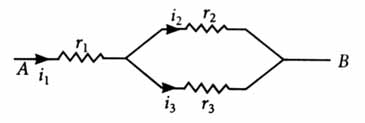
From eqn. (i) and (ii),
or
Q 6
:
The effective resistance of a parallel connection that consists of four wires of equal length, equal area of cross-section and same material is . What will be the effective resistance if they are connected in series? [2021]
4
0.25
0.5
1
(1)
Given that, four wires of same material, equal area of cross-section and equal length.
Resistance of each wire is
For parallel combination,
When wires are connected in parallel,
So, resistance of each wire is .
Now, wires are connected in series. Then, equivalent resistance is
Hence, the equivalent resistance in series will be .
Q 7
:
In the circuits shown below, the readings of the voltmeters and the ammeters will be [2019]
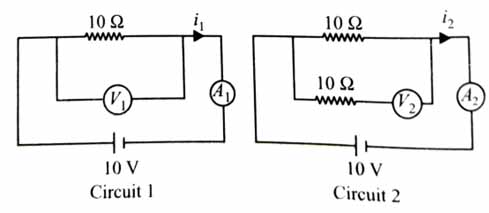

and
and
and
and
(4)
Q 8
:
Six similar bulbs are connected as shown in the figure with a DC source of emf E, and zero internal resistance. The ratio of power consumption by the bulbs when
(i) all are glowing and
(ii) in the situation when two from section A and one from section B are glowing, will be [2019]
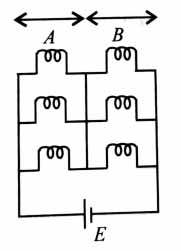
(i) all are glowing and
(ii) in the situation when two from section A and one from section B are glowing, will be [2019]

2 : 1
4 : 9
9 : 4
1 : 2
(3)
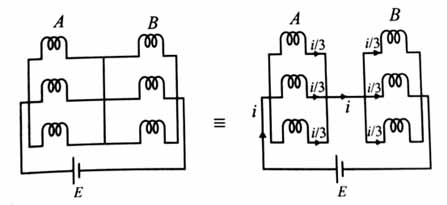
Let R be the resistance of each bulb.
Case (i)
Net resistance of the circuit,
Power consumption by the bulbs = Power supply by the sources
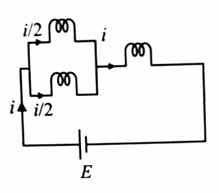
Case (ii)
Net resistance of the circuit,
Power consumption by the bulbs,
Q 9
:
A filament bulb (500 W, 100 V) is to be used in a 230 V main supply. When a resistance is connected in series, it works perfectly and the bulb consumes 500 W. The value of is [2016]
230 Ω
46 Ω
26 Ω
13 Ω
(3)
Resistance of bulb,
Power of the bulb in the circuit,
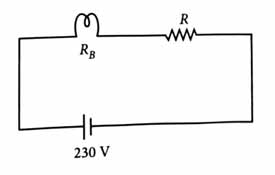
Q 10
:
Two metal wires of identical dimensions are connected in series. If and are the conductivities of the metal wires respectively, the effective conductivity of the combination is [2015]
(3)
As both metal wires are of identical dimensions, so their length and area of cross-section will be same. Let them be and respectively. Then the resistance of the first wire is
...(i)
and that of the second wire is ...(ii)

As they are connected in series, their effective resistance is
(using (i) and (ii))
...(iii)
If is the effective conductivity of the combination, then
...(iv)
Equating eqns. (iii) and (iv), we get

